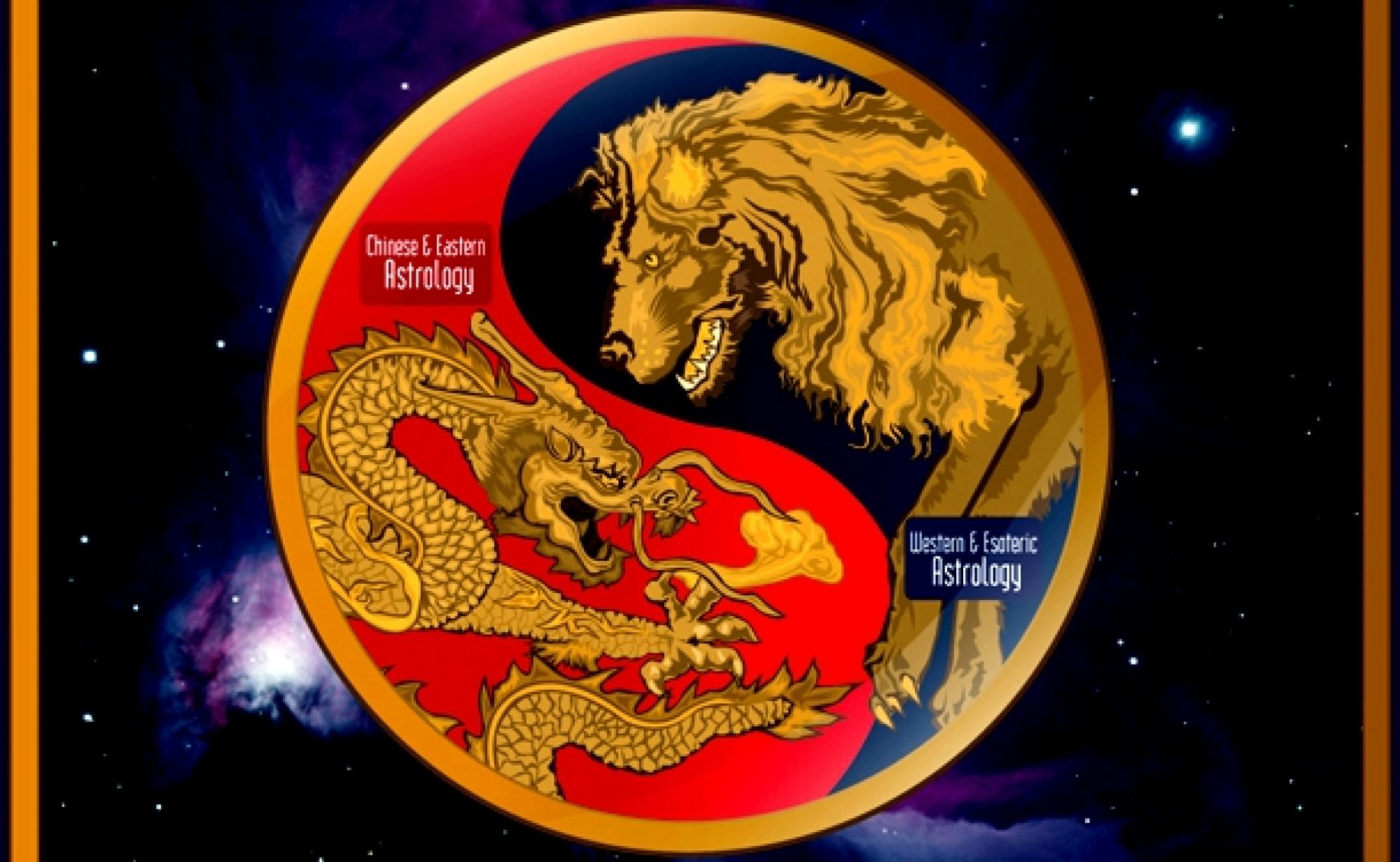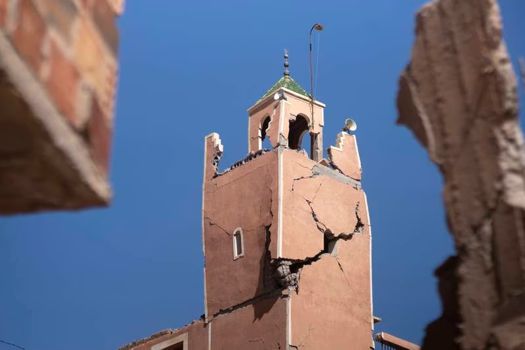On the night of September 8th a major earthquake struck Morocco south of Marrakesh in the High Atlas Mountains. To date almost 3,000 people have been killed by the falling rubble. Morocco is an ancient country with many buildings in its historic sections that are not reinforced against quakes. The same is true in the rural areas of the country. We’ll have a look at the astrology of the event here, as well as a proposed chart for Morocco. And there is more…
Regarding the quake, an early Wikipedia entry has the following:
“A Mww 6.8 earthquake struck the Marrakesh-Safi region of Morocco on 8 September 2023. The earthquake had an epicenter located 71.8 km (44.6 mi) southwest of Marrakesh, near the town of Ighil in the Atlas Mountains.[1] It occurred as a result of shallow oblique-thrust faulting beneath the mountain range. At least 2,862 deaths were reported; most occurred outside Marrakesh. Damage was widespread; buildings and historic landmarks in Marrakesh were damaged. The earthquake was also felt in Spain, Portugal, and Algeria.”
That region of Morocco is in a moderately active earthquake zone. The zone rates a 2 out of 4, 4 being weakest. The scale runs from 0 – 4, with 0 being a zone of extreme danger from a powerful quake. The rating system is based upon building codes. The quake occurred in a transition zone, between a 1 and a 2, seen below:
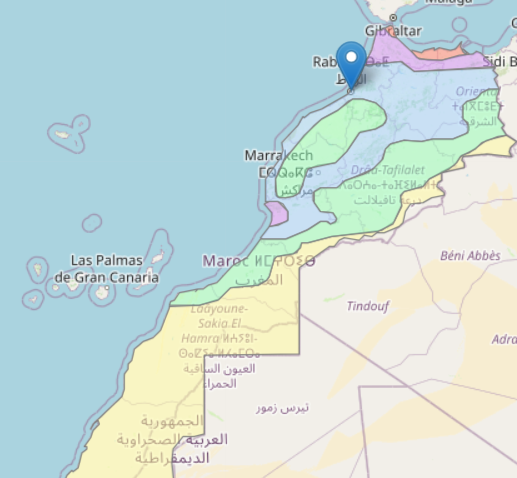
The quake took place in a mountainous region. Such regions are often sites of earthquakes, some of the more famous being the San Gabriel mountains in California, the Apennines in Italy and the Southern Alps in New Zealand, all having resulted from tectonic plate movements along the fault lines those mountains border. This particular quake was in the High Atlas Mountains, along a minor fault line. The zone affected is shown below, from the USGS site:
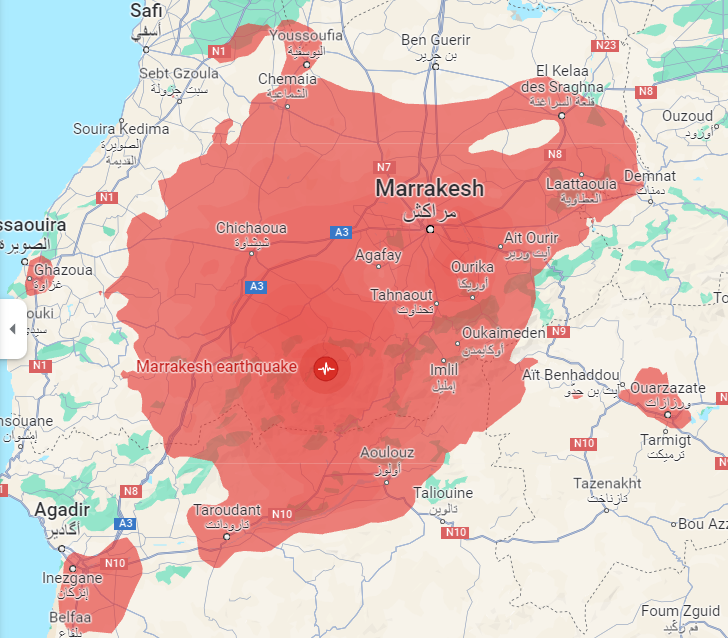
Such large quakes are not common in that region of the Atlas Mountains, but they do occur. The largest one in recent memory in that region was the 1960 Agadir quake, which killed 12,000 and almost leveled the entire city. With this background in mind we move on to the chart of the event, which is below (bigger):
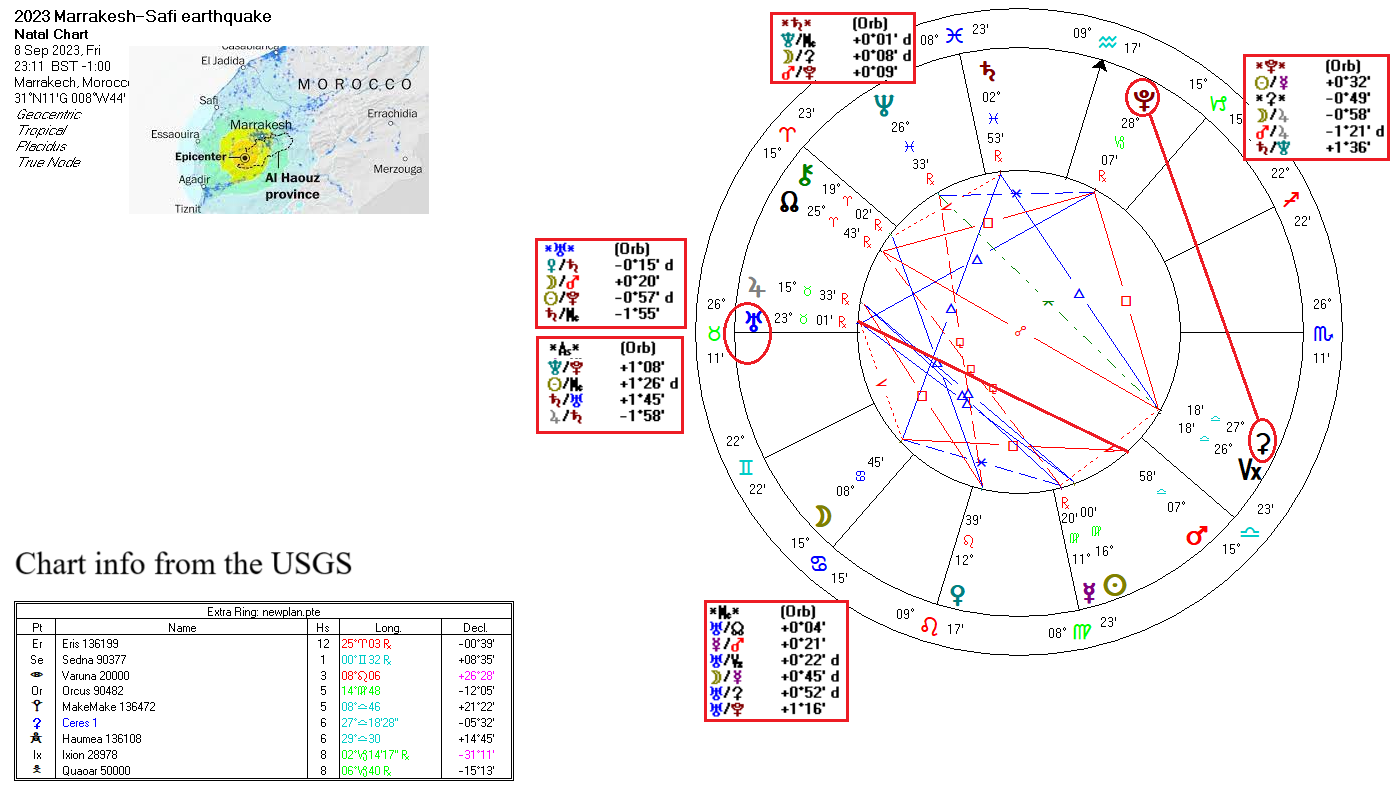
The immediate standout is Uranus conjunct the Ascendant, just behind in the 12th house (hidden dangers) in Taurus (the land and the Earth), telling us an unusual event is in store and possibly shocking in its manifestation. Nothing is ever to go as expected when Uranus is prominent in a chart, except for the expectation of change and a reordering of one’s life. There are several factors generally indicated in earthquakes in standard practice – Uranus (sudden shocks), Pluto (movements beneath the Earth’s crust) and the 4th house (buildings and infrastructure).
We note the Uranus/Pluto midpoint just within orb of the Meridian axis, which includes the 4th house: “The process of transformation. (The collapse of the old order of things, the construction of the new). Revolution.” In disasters, that midpoint has the following interpretation: “Acts of violence, upsets, subversive activities, putting the gun to someone’s head, the enforcement of decisions, an accident.” An earthquake can be seen as a subversive activity, because the normal placement of seismic plates is upset in such an event.
Damage to buildings is indicated by the Saturn/Uranus midpoint, specifically when Jupiter is at that midpoint: “The ability to adapt oneself to every situation, a fortunate release from tensions. – A sudden turn (in destiny), the misfortune to get into difficulties. – Losses, damage to buildings, motor damage.” But Jupiter is not involved here…or is it? We note the Jupiter/Saturn midpoint, straddling the Ascendant on the other side of the Saturn Uranus midpoint. We thus have the string: Sat/Ura=Asc=Jup/Sat.
The midpoint Asc=Jup/Sat has the following interpretation: “An inconstant or an insecure attitude with regard to other persons. – A change of residence, a change of occupation, a separation.” With all this midpoint activity to the Ascendant, along with the Uranus conjunction, we see this was indeed a very significant and life-altering event. Jupiter finds indirect involvement with the Saturn/Uranus midpoint via the Ascendant – the collapse of the old order, damage to buildings, a change of residence and separations.
Next we turn to the chart of Morocco to see what was indicated there, and the story becomes clear. The proposed chart with transits and directions is below (bigger):
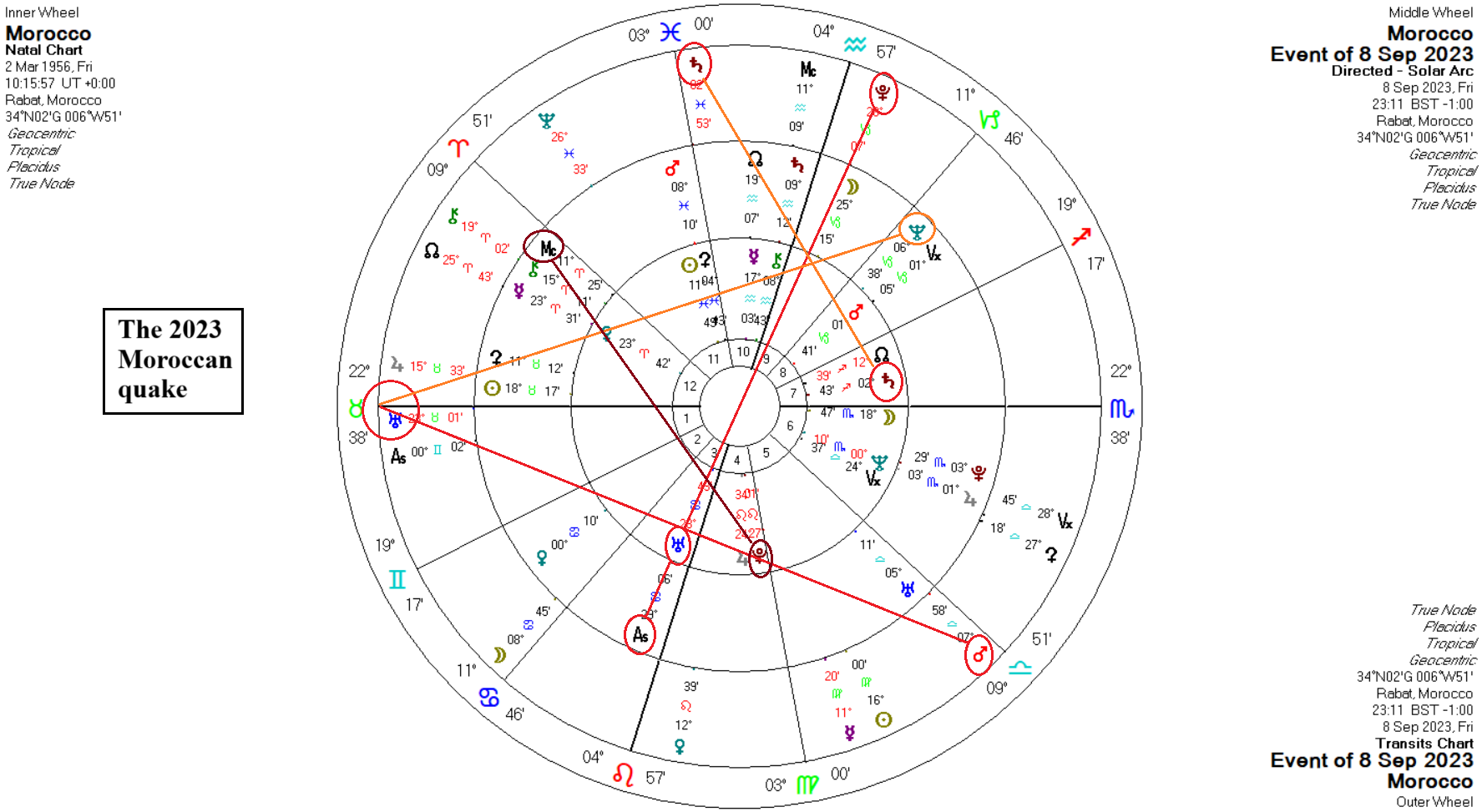
The chart for Morocco is rectified, for the 2nd of March 1956, at about 10:16 in the morning. It has been checked against past events, notably the installment of the monarchy (11 Aug 1957), the Agadir quake (29 Feb 1960), the cession of the region of Ifni from Spain to Morocco (30 Jun 1969), the Spanish cession of Western Sahara to Moroccan control (26 Feb 1976, and still unresolved) and concessions by the king as a result of the Arab Spring (20 Feb 2011), all shown by the solar arcs and contributing transits. Chart proving is still ongoing, as the chart for independence is disputed, though Moroccans celebrate their independence on 2 March every year.
For the present quake the indicators are clear enough, especially the transit of Uranus over the Ascendant accompanied by a Mars transit at sesquisquare activating a Neptune direction to the Ascendant, and most particularly the transit of Pluto activating the directed Ascendant to natal Uranus – a sudden and very destructive event. We also note the directed Meridian axis in a 45° modulus to the natal Pluto.
The death toll and injuries from this quake continue to climb. Many of the buildings that collapsed were quite old, some of them ancient and were not built to withstand earthquakes. Some of the losses of the old heritage are priceless. Most of the deaths occurred in rural areas, where building codes are lax at best. Seismologists have the following to say about quakes:
“Seismologists know that earthquakes do not kill people – buildings do. Buildings with lack of regulation and lack of structural support are potential killers in high seismic hazard areas. Building codes must therefore be mandatory, and should be updated periodically.”
Further on with the preceding, there is this, from Mehrdad Sasani, a professor of civil and environmental engineering, regarding where the quake struck:
“The most important problem here is that in that region, mud-brick construction and unreinforced masonry construction seems to be prevalent, and they fail when earthquakes come,” Mehrdad Sasani, a professor of civil and environmental engineering at Northeastern University says. Sasani is an expert in building collapse, and community and building resilience.
“We have seen that (failure) in the past, over and over again,” Sasani said. “It’s unfortunate — it’s a societal, economic and technical problem — and we will see repetitive problems where earthquakes will cause such damage.” But Sasani said updated building techniques would be hard to implement in the rural, mountainous and largely undeveloped area of Morocco where the quake struck.”
Sad, but true enough. So, unless there is political will in Morocco, the next time a big quake comes – and they are not uncommon – we are likely to see the same sorts of tragic results from quakes there. And it is a strange thing that quakes sometimes come in the night, when people are at home, asleep. Such was the case with this one. We pray for a speedy recovery for the people of Morocco.
Featured pic from The National
